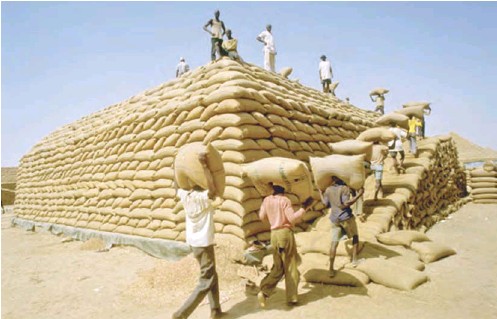Groundnut pyramids have become a symbol of national nostalgia for Nigerians. They get mentioned in laments and rants critical of the country’s economic state, and are referred to in school history classes and in discussions by older citizens who remember the “good old days” when things worked as they should.
But there was a time in which these groundnut pyramids were more than objects of collective memory; they were real, physical structures, towering far above the humans who built them. Heavy bags of groundnut, piled sack upon sack, like the pyramids of ancient Egypt. The old monochrome pictures of these edifices testify of a golden age in agriculture, one in which Nigeria could afford to display- or show off -its food surpluses.
Age of agricultural boom
The groundnut pyramids were indeed a sight to behold. In their heydays- the 1960s and 70s -you could find rows and rows of these huge structures, sometimes holding as much as 15,000 full groundnut bags, at collection fields.
It all began in the early 1910s, when farmers in northern Nigeria were attracted to the groundnut crop because of the significant returns it gave its growers. Demand from colonial merchants was a big factor. One local trader, Alhassan Dantata, supplied groundnuts to the Royal Niger Company. His enterprise grew so large that he was able to amass bags of groundnut in their thousands, and display them in pyramidal heaps, before having them shipped. It was he who began the tradition of the groundnut pyramids.
The pyramids reached their zenith in the 1950s and 60s; between 1956 and 1967, groundnut was Nigeria’s most valuable single export crop. Sacks stuffed with the nut were assembled in huge heaps the shape of a pyramid, in towns and cities like Kano, Malam Madori, Bebeji, and Dawakin Kudu. And they weren’t just symbols of economic prosperity; they were tourist attractions as well. The world marveled at the ingenuity of the structures, but even more at the industry of the largely peasant farmers who had produced the commodity.
Interestingly, this high point coincided with Nigeria’s emergence from colonial overseership. The country teemed with people determined to make the most of their new found freedom. The pyramids were a symbol of this striving; postage stamps from that period, which bore images of the nut sack towers, suggest so.
What happened to the groundnut pyramids?
Most people have a one word answer to this question: Oil. But that answer is only part of a bigger story.
The Nigerian government did turn its back on agriculture after oil revenues began pouring in. Beginning in the 1970s, the country’s attention shifted to petro-dollars, and very rapidly became heavily dependent on income from crude oil exports.
In time, this neglect of agriculture began to tell on the sector. A combination of environmental factors threatened groundnut production in the 1980s. Droughts became more frequent and widespread in the north. A rosetta virus epidemic wiped out more than 750,000 hectares of the groundnut crop in the region, and inflicted further losses in the decade that followed. Farmers had to abandon groundnut for other crops, such as millet, sorghum and cowpea. The groundnut pyramids gradually receded from reality and into the realm of memory.
The government couldn’t do much to save the pyramids. It had racked up debts throughout the oil boom, which it was struggling to repay when oil prices sank in the 1980s. In trying to resuscitate Nigeria’s ailing economy, it had to agree to the IMF’s Structural Adjustment Program (SAP). As a result, it dismantled the marketing boards and removed agricultural subsidies. These measures, along with the prevailing environmental challenges at that time, forced a plunge in groundnut production.
Will the pyramids ever come back?
Expert opinion suggests we’ve seen the last of the groundnut pyramids. There’s a much bigger demand for the commodity these days; the distribution systems have become more decentralized and complex, and the produce is now being used in more diverse ways than before. All of these don’t allow for groundnuts to be collected and stored long enough to be mounted into mighty structures.
In fact, things have changed so much with the commodity’s distribution and use, that most people don’t realize we’re actually producing more groundnuts than we were in the glory days of the nut pyramids. In 2016, Nigeria churned out 3 million tons of groundnut, compared to the 1.9 million tons it piled up in 1965.
But the symbolism of the groundnut pyramid lives on. It has inspired governments in such states as Borno and Ogun to attempt something similar: rice pyramids. Not surprisingly, these recent displays remain in the shadows of the original thing, their now revered predecessor: the groundnut pyramids of our fabled golden age.

